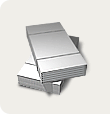There are two main ways to process metal, which results in high quality parts: milling and turning. Both types of metalworking are fundamental for almost any serious machine-building production, since at such an enterprise up to 90% of the parts are made of metal.
Unlike turning work, milling is performed by rotating the tool that trims the metal, that is, using a milling cutter. Almost all milling work to order is performed according to the same scheme: first, there is a study or creating a drawing of a future part. Then the equipment is set up if the machine is equipped with some semblance of artificial intelligence. Further, the metalworking process takes place.
During metalworking, the cutter in the process of rotation cuts the workpiece, which moves progressively towards the tool. The main task of such machines is to process the surface of a metal workpiece. Such processing is carried out using a special wheel with teeth - a cutter. In this case, the wheel itself is made of high-strength steel so that it can withstand any mechanical stress that it will have to face during operation.
Before milling work, the part undergoes turning on the appropriate machine and the main task of the milling master is to give the product the required shape. Moreover, all machines can be divided into three global types depending on how the cutting tool is located: vertical, horizontal and universal. Regardless of the type of machine, steps, grooves, chamfers and various gear elements can be made with the same efficiency.
Almost the entire list of metal processing works can be performed using two types of machines: milling or turning. On them, a professional can perform planing, turning, drilling, reaming, milling, broaching and grinding. The widespread introduction of computers also affected metalworking, which had a positive effect on the capabilities of modern machine tools. Most of these machines can perform a number of operations according to a predetermined program. The result of such a program can be parts of almost any shape and mass, which makes it possible to use such equipment for solving almost any task.
Agricultural machinery is one of the areas of mechanical engineering that could not function well without high-quality metal parts. A large number of belt conveyors are available in almost every type of such equipment. And it is logical that more than one Inclined Belt Conveyor cannot work correctly and for a long time without the necessary supply of parts. All these metal parts must exactly match their dimensions on the drawings and provide the necessary margin of safety, which is very large in agricultural conditions.
An average inclined belt conveyor consists of tension belts, a metal rotation coupling, a gearbox and its drive. All these details are to one degree or another created as a result of various works with metal. And only high-quality raw materials, reliable and modern machines and, of course, experienced personnel can provide the required level of detail.
Parts milling in mechanical engineering

|
|
Azovpromstal® 13 August 2013 г. 11:35 |
Subscribe to news 
Metallurgy news
- Today
15:00 15:00 15:00 14:00 Japan's industrial production fell 2.6 percent in November 2025 compared to October. 14:00 U. S. Congresswoman Delbene is reintroducing the Clean Competition Act to limit carbon dioxide leakage and boost production.
13:00 China claims 59% of new shipbuilding orders worldwide in January-November 2025 13:00 BCSD Turkey sets out 14 recommendations for companies making the transition to a green economy 12:00 PASSAD: Turkish stainless steel industry enters 2026 with new expectations
Publications
26.12 Keratin for hair care restoration and protection 25.12 Diode lasers from Alvi Prague 25.12 Services of the exporter of Budivelny Smith 24.12 old furniture - how to dispose of it correctly 24.12 The computer does not start, beeps or shows a black screen: diagnostics by sounds and what to fix





